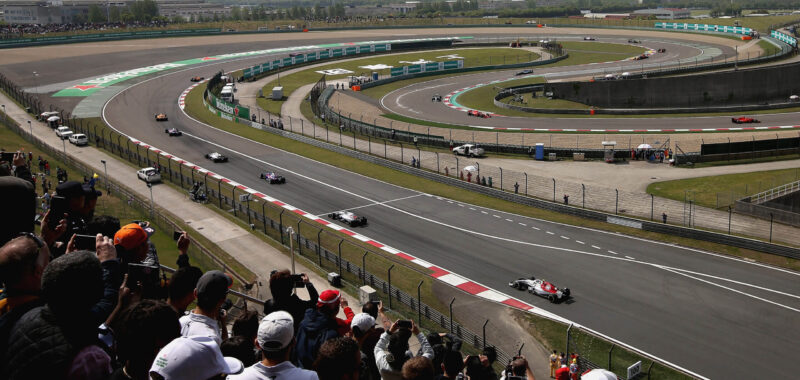Sprint weekends are a mad dash and a headache within the world of Formula One, but when the sport returns to a track it hasn’t competed on since 2019, sprint races become even more challenging.
F1 returns to China in a few days after a five-year absence due to the COVID-19 pandemic and the country’s subsequent heavy restrictions, which didn’t begin lifting until December 2022. That being said, F1 didn’t race in the country the following year because of “the ongoing difficulties presented by the COVID-19 situation.”
The 2024 Chinese GP will also mark the first sprint race weekend of the year. The sprint format remains the same this season—one practice session, two qualifying sessions, a sprint race, and the grand prix — but the scheduling has been tweaked. Sprint qualifying has been moved to Friday and the sprint race earlier on Saturday, with qualifying for the grand prix to follow. However, only having one practice session, particularly given the circumstances for this weekend, creates a sticky point for teams and drivers.
“Yeah, it’s very smart to do that,” Max Verstappen said sarcastically after winning the Japanese GP. In a more serious tone, he added, “It’s not great to do that because when you have been away from a track for quite a while, I think you never know what you’re going to experience, right? So it would have been better to have a normal race weekend there. But on the other hand, it probably spices things up a bit more, and that’s maybe what they would like to see.”
The drivers and teams face quite a lot of unknowns as they prepare to tackle the Shanghai International Circuit. The track has been resurfaced, meaning there’s not as much valid data available compared to other tracks to help the teams prepare ahead of FP1. They’re also driving a new generation of car compared to when they last competed in China in 2019.
“I just hope that there are no issues with the track, with any drain holes, any issues like that. That will just put us out of sync,” Sergio Pérez said. He does recognize that a sprint weekend in China is “a good thing” for “the show” of the sport. However, “from the preparation side, it’s going to be definitely one that is going to be really hard because, I mean, I’ve never raced there, for example, with Red Bull so it’s going to be quite a lot to do in a single practice.”

The Shanghai Circuit has been repaved since F1 last raced there in 2019. (Lars Baron/Getty Images)
And Pérez isn’t the only one who hasn’t raced with his current team at this track. The grid has changed quite a bit since the last Chinese Grand Prix. Pérez isn’t the only one who hasn’t raced with his current team at this track. To name a few, Pierre Gasly was with Red Bull, and Carlos Sainz was with McLaren that season. Multiple names are no longer part of the driver lineup, like Sebastian Vettel (who drove for Ferrari that season) and Kimi Räikkönen (who was with Alfa Romeo) — both of whom are retired. Racing Point and Renault were still teams, and it was the rookie year for Alex Albon, George Russell and Lando Norris.
A majority of the grid has raced on this track before, but the likes of Oscar Piastri and Logan Sargeant, F1’s rookies in 2023, haven’t ever raced here.
Now, it’s a fresh start at a track the drivers do enjoy. The early grumblings about a sprint weekend at the Shanghai International Circuit don’t seem related to the layout. As Sainz said in Japan, “It’s one of our favorite ones for everyone. It’s just a great racing track and a track that offers a good possibility to overtake, so a sprint makes sense to have it there.” The first few corners of the track are quite unique and almost snail-shaped. Turns 1-2 send them for a near-loop before switching to a U-turn at Turn 3. Further into the lap, Turns 11-12-13 are critical to nail because of the long straight (with a DRS zone). A solid exit will help the drivers as they head into the hairpin at the end of the straight, which is a potential overtaking point.
As the Spaniard noted, it “makes sense” to host a sprint race here when looking at the layout and racing potential.
Rather, the concerns stem from the track’s absence from the calendar and a single practice session. Sainz said they discussed the sprint race in China during a drivers’ briefing. “We say to FIA and Formula One, with these kind of cars, to go to a track with one hour of practice and straight into qualifying, with the regulations that they put us, with the plank wear and things like this, and how tricky one bump could make the car, I think it’s not a good choice to choose to put the sprint after four or five years absence,” the Ferrari driver said. “We also heard there’s been resurfacing going on, so Istanbul 2.0 may be on the cards. Yeah, I hope not.”
The “Istanbul 2.0” scenario that Sainz mentioned is about the 2020 Turkish GP weekend when the track was resurfaced just a few weeks before F1 returned. The sport hadn’t competed there since 2011, and the drivers struggled with grip during the Friday practice sessions, some going as far as describing the track surface as an “ice rink.”
“It just shows the uncertainty,” Sainz said in Japan. “Maybe for you guys at home, it’s exciting, but for engineers and drivers, it’s something that for me, in my opinion, we shouldn’t take the risk and have a normal weekend.”
Top photo: Charles Coates/Getty Images

